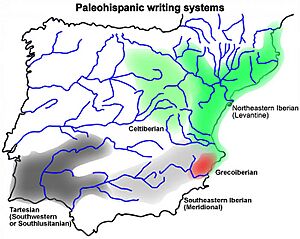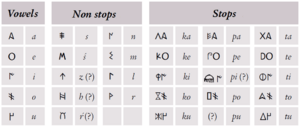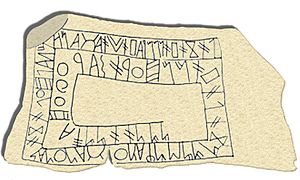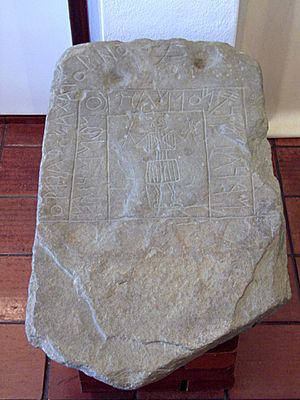Southwest Paleohispanic script facts for kids

The Southwest Script is an ancient writing system from the Iberian Peninsula. People used it to write a language that we don't fully understand. This language is often called Tartessian. Most of these ancient writings have been found in southern Portugal and parts of southern Spain.
Contents
What is the Southwest Script?
The Southwest Script is a type of Paleohispanic script. These are old writing systems used in the Iberian Peninsula before the Romans arrived. The Southwest Script is also known by other names, like Tartessian or South Lusitanian.
Why Does the Script Have Different Names?
People don't agree on the best name for this ancient writing system. Here are some of the names and why they are used:
- Southwestern: This name is simple. It just describes the area where the writings were found.
- Tartessian: Some people believe this script was used by the people of Tartessos. This was an ancient city or region. However, not many writings were found in the area of Tartessos itself.
- South Lusitanian: Most of the writings were found in southern Portugal. This area later became a Roman province called Lusitania. But this name might make people think it's related to the Lusitanian language, which it isn't.
- Conii Writing: Ancient Greek and Roman writers said the Conii or Cynetes people lived where most of these writings were found.
How Do We Understand This Ancient Script?
Scientists are still working to fully understand the Southwest Script. It's not like the northeastern Iberian script, which is mostly understood. Researchers use two main ways to figure out what the letters mean:
- Comparing Letters: They look for letters that look similar to those in other ancient writing systems. These include the Phoenician alphabet and other Iberian scripts. If a letter looks the same and has a similar sound in other scripts, they guess it has the same sound in the Southwest Script.
- Looking at the Language Itself: They study how often certain letters appear. They also look at how letters are used together. This helps them guess their sounds.
If both methods agree, the letter's sound is considered known. If not, it's still a guess. By 2014, about 20 letters were understood. These include all 5 vowels and 15 consonants.
Because we don't fully know the sounds of all the letters, it's hard to know what language the script represents. Some experts think it might be a Celtic language. If true, it would be the first Celtic language ever written down! Others think it's an Iberian language or a language with some Celtic influence.
How the Southwest Script Works
Most ancient Iberian scripts were special. They used a mix of an alphabet and a syllabary. This means they had separate letters for vowels and some consonants, like an alphabet. But for other consonants, they used signs that stood for a whole syllable (like "ba," "be," "bi"). This unique system is called a semi-syllabary.
The Southwest Script is a bit different. When writing a syllable with a consonant and a vowel (like "ka"), it used a special sign for the "k" sound that changed based on the vowel that followed. But it also wrote the vowel separately! This is unusual. Some experts call it a "redundant semi-syllabary" or a "redundant alphabet."
This script is very similar to the southeastern Iberian script. They share many letter shapes and sounds. The main difference is that the southeastern script doesn't repeat the vowel sound like the Southwest Script does.
Where Are the Inscriptions Found?
Almost all Southwest Script writings are found on large stones called steles. About 100 of these stones have been found. Sadly, 10 of them have been lost over time. Most were discovered in modern-day Portugal, especially in the Baixo Alentejo region. Some have also been found in Spain.
You can see 16 of these steles at the Southwest Script Museum in Almodôvar, Portugal. The longest inscription found so far, with 86 characters, is also on display there. It was discovered in 2008.
These inscriptions were likely used for funerals. However, it's hard to be sure because we don't always know exactly where they were found. We also can't say for sure when they were made. But experts believe they are from the Iron Age, between the 8th and 6th centuries BCE. Many think the Southwest Script is the oldest of all the ancient Iberian scripts.
The writing usually goes from right to left. But sometimes it can go in different directions, like a boustrophedon (changing direction on each line) or even in a spiral.
See also
- Paleohispanic scripts
- Pre-Roman peoples of the Iberian Peninsula
- Prehistoric Iberia
- Timeline of Portuguese history
- Cempsi and Saefs
- Celtici
 In Spanish: Escritura tartésica para niños
In Spanish: Escritura tartésica para niños





